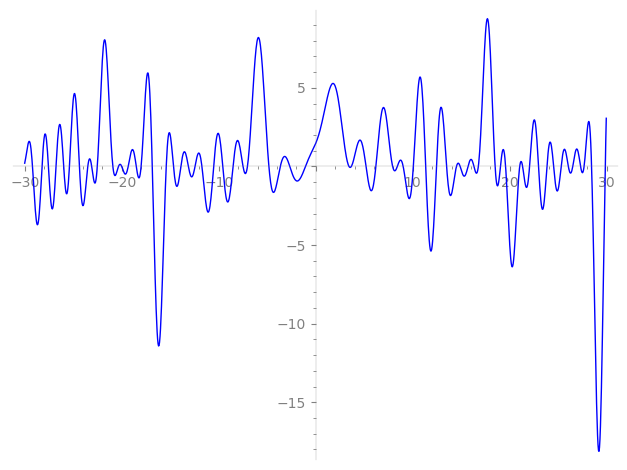| L(s) = 1 | + (0.255 − 1.39i)2-s + (1.92 − 1.92i)3-s + (−1.86 − 0.712i)4-s + (−2.22 + 0.200i)5-s + (−2.18 − 3.16i)6-s + (−0.516 − 2.59i)7-s + (−1.46 + 2.41i)8-s − 4.40i·9-s + (−0.291 + 3.14i)10-s + 5.44i·11-s + (−4.96 + 2.22i)12-s + (1.42 − 1.42i)13-s + (−3.74 + 0.0540i)14-s + (−3.90 + 4.67i)15-s + (2.98 + 2.66i)16-s + (4.92 − 4.92i)17-s + ⋯ |
| L(s) = 1 | + (0.180 − 0.983i)2-s + (1.11 − 1.11i)3-s + (−0.934 − 0.356i)4-s + (−0.995 + 0.0895i)5-s + (−0.891 − 1.29i)6-s + (−0.195 − 0.980i)7-s + (−0.519 + 0.854i)8-s − 1.46i·9-s + (−0.0922 + 0.995i)10-s + 1.64i·11-s + (−1.43 + 0.642i)12-s + (0.395 − 0.395i)13-s + (−0.999 + 0.0144i)14-s + (−1.00 + 1.20i)15-s + (0.746 + 0.665i)16-s + (1.19 − 1.19i)17-s + ⋯ |
\[\begin{aligned}\Lambda(s)=\mathstrut & 280 ^{s/2} \, \Gamma_{\C}(s) \, L(s)\cr =\mathstrut & (-0.957 + 0.289i)\, \overline{\Lambda}(2-s) \end{aligned}\]
\[\begin{aligned}\Lambda(s)=\mathstrut & 280 ^{s/2} \, \Gamma_{\C}(s+1/2) \, L(s)\cr =\mathstrut & (-0.957 + 0.289i)\, \overline{\Lambda}(1-s) \end{aligned}\]
Particular Values
| \(L(1)\) |
\(\approx\) |
\(0.215186 - 1.45494i\) |
| \(L(\frac12)\) |
\(\approx\) |
\(0.215186 - 1.45494i\) |
| \(L(\frac{3}{2})\) |
|
not available |
| \(L(1)\) |
|
not available |
\(L(s) = \displaystyle \prod_{p} F_p(p^{-s})^{-1} \)
| $p$ | $F_p(T)$ |
|---|
| bad | 2 | \( 1 + (-0.255 + 1.39i)T \) |
| 5 | \( 1 + (2.22 - 0.200i)T \) |
| 7 | \( 1 + (0.516 + 2.59i)T \) |
| good | 3 | \( 1 + (-1.92 + 1.92i)T - 3iT^{2} \) |
| 11 | \( 1 - 5.44iT - 11T^{2} \) |
| 13 | \( 1 + (-1.42 + 1.42i)T - 13iT^{2} \) |
| 17 | \( 1 + (-4.92 + 4.92i)T - 17iT^{2} \) |
| 19 | \( 1 + 3.36iT - 19T^{2} \) |
| 23 | \( 1 + (-1.59 + 1.59i)T - 23iT^{2} \) |
| 29 | \( 1 + 2.04T + 29T^{2} \) |
| 31 | \( 1 - 1.78iT - 31T^{2} \) |
| 37 | \( 1 + (1.63 - 1.63i)T - 37iT^{2} \) |
| 41 | \( 1 - 1.17iT - 41T^{2} \) |
| 43 | \( 1 + (5.08 + 5.08i)T + 43iT^{2} \) |
| 47 | \( 1 + (1.67 - 1.67i)T - 47iT^{2} \) |
| 53 | \( 1 + (-8.44 - 8.44i)T + 53iT^{2} \) |
| 59 | \( 1 - 8.44iT - 59T^{2} \) |
| 61 | \( 1 - 3.37T + 61T^{2} \) |
| 67 | \( 1 + (5.38 - 5.38i)T - 67iT^{2} \) |
| 71 | \( 1 - 10.6T + 71T^{2} \) |
| 73 | \( 1 + (-2.52 - 2.52i)T + 73iT^{2} \) |
| 79 | \( 1 - 5.29iT - 79T^{2} \) |
| 83 | \( 1 + (0.118 - 0.118i)T - 83iT^{2} \) |
| 89 | \( 1 - 0.578T + 89T^{2} \) |
| 97 | \( 1 + (-1.57 + 1.57i)T - 97iT^{2} \) |
| show more | |
| show less | |
\(L(s) = \displaystyle\prod_p \ \prod_{j=1}^{2} (1 - \alpha_{j,p}\, p^{-s})^{-1}\)
Imaginary part of the first few zeros on the critical line
−11.73221341860111187824877259599, −10.52017503211743870375064423061, −9.582726769001225595714736467592, −8.524389822104471064450747836399, −7.49242370719777830464186452241, −7.03986793471637750386561011235, −4.82581947126045779394220130879, −3.65149834050434482391708029307, −2.67118155375199095044419774751, −1.05483879993791642173933915879,
3.42997810224932484586988914977, 3.66871864495469598232033762729, 5.18702945994698444644457597455, 6.19915030081933529227279494389, 7.929350316139929629368639217858, 8.409647013005990023461644860697, 9.014114983029514959798470058847, 10.06204181358239565601331626174, 11.33625847482537713345509431719, 12.44659478398302648921108261784

